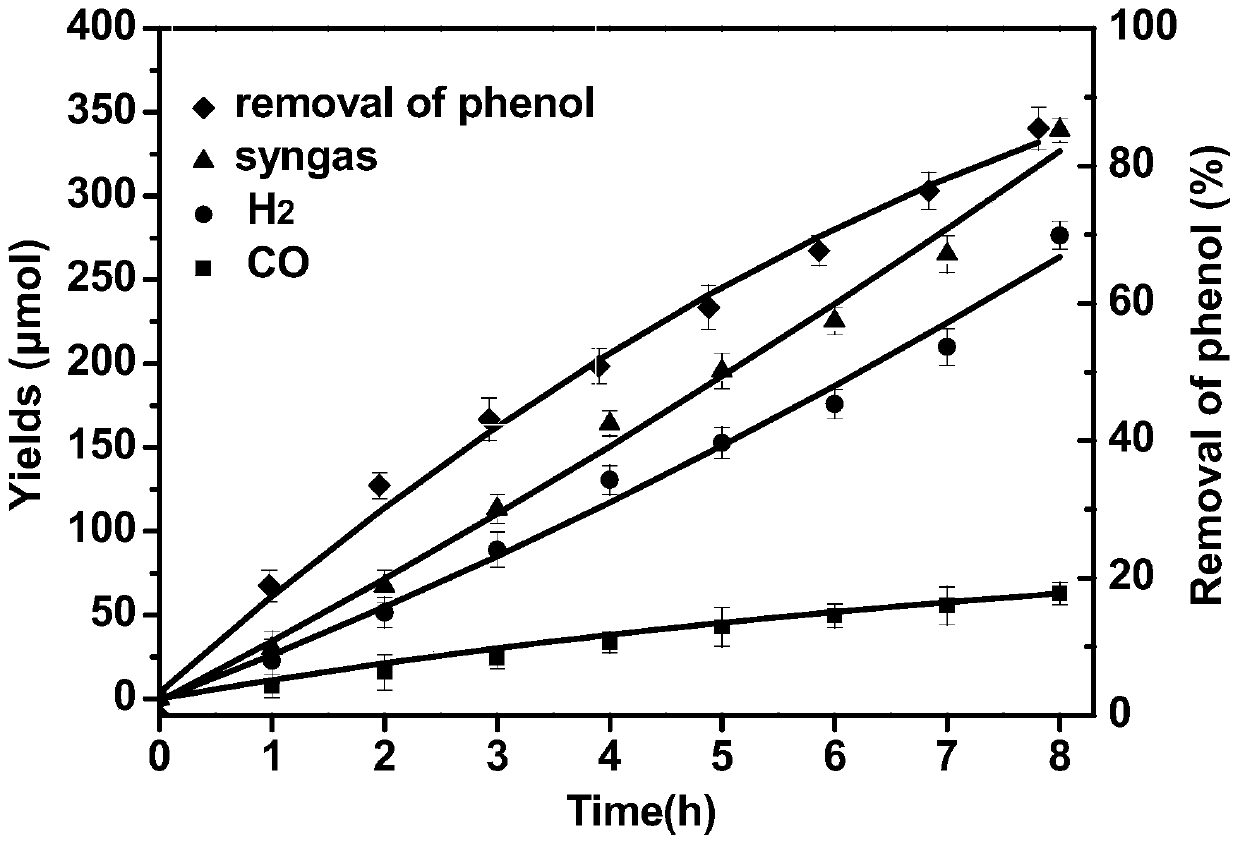Photoelectrocatalytic system and method for directionally converting degraded organic pollutants into synthesis gas
A technology of organic pollutants and photoelectric catalysis, applied in water pollutants, chemical instruments and methods, electrolysis process, etc. The effect of photocorrosion
- Summary
- Abstract
- Description
- Claims
- Application Information
AI Technical Summary
Problems solved by technology
Method used
Image
Examples
Embodiment 1
[0023] An electrode material and preparation method for photoelectrocatalytically degrading pollutant phenol while converting degradation products into synthesis gas. The specific preparation process includes the following steps:
[0024] (1) The surface of the pure Ti plate (1.5cm×5cm) was polished with 180#, 320# and 600# sandpaper in sequence, and then the surface of the electrode was polished with metallographic sandpaper until the surface was smooth and flat. After ultrasonic cleaning in acetone, ethanol and distilled water for 15 min, the 2 The atmosphere is dry.
[0025] (2) A two-electrode system is adopted, the Pt sheet is used as the cathode, and the Ti sheet is used as the anode. 4 F and 2.0vol%H 2 In the ethylene glycol solution of O, the pure Ti plate was anodized in the first step (60V, 4h) at a constant temperature of 25°C, washed with distilled water and dried, and the irregular TiO on the surface was peeled off. 2 NTs, hexagonal pits with an ordered structu...
Embodiment 2
[0030] Using the experimental conditions of Example 1, the cathode materials are Pd-Cu and Cu respectively, and after the cathode is modified with Pd, the gas phase reduction product CO of the cathode is twice that of the pure copper mesh. It further illustrates that the cathode material of the present invention has good reduction performance. It can be seen from the comparison that the Pd-modified copper mesh has a good effect on CO 2 Reduction has relatively excellent performance.
[0031] As can be seen from Examples 1 and 2, the Pd QDs-TiO prepared by the present invention 2 NTs, Pd-Cu materials, and the designed system and method can realize the degradation of organic pollutants at the anode while the product CO 2 The purpose of reducing to syngas, and both cathode and anode materials show excellent performance. Through calculation, the carbon conversion rate is 9.52%. If 1t of phenol is degraded, there will be 44kg of carbon that does not need to be emitted and can be...
Embodiment 3
[0033] Pd QDs-TiO prepared by the method of Example 1 2 NTs is the anode material, Pd-Cu is the cathode material, phenol is the target pollutant, its concentration is 100mg / L, a single-chamber two-electrode system, the constant current density is 3mA cm -2 , in the generated syngas, the carbon-to-hydrogen ratio is 0, that is, no hydrogen is produced and only CO is produced; when the current density is 5mA cm -2 , the ratio of carbon to hydrogen in the syngas is 1:3; when the current density is 10mA cm -2 , the ratio of carbon to hydrogen is 1:6; when the current density is 20mA cm -2 When the ratio of carbon to hydrogen is 1:6.6, that is, controlling different current densities can change the ratio of carbon and hydrogen in the synthesis and reduce the cost of further processing to generate downstream products.
PUM
 Login to View More
Login to View More Abstract
Description
Claims
Application Information
 Login to View More
Login to View More - R&D
- Intellectual Property
- Life Sciences
- Materials
- Tech Scout
- Unparalleled Data Quality
- Higher Quality Content
- 60% Fewer Hallucinations
Browse by: Latest US Patents, China's latest patents, Technical Efficacy Thesaurus, Application Domain, Technology Topic, Popular Technical Reports.
© 2025 PatSnap. All rights reserved.Legal|Privacy policy|Modern Slavery Act Transparency Statement|Sitemap|About US| Contact US: help@patsnap.com

